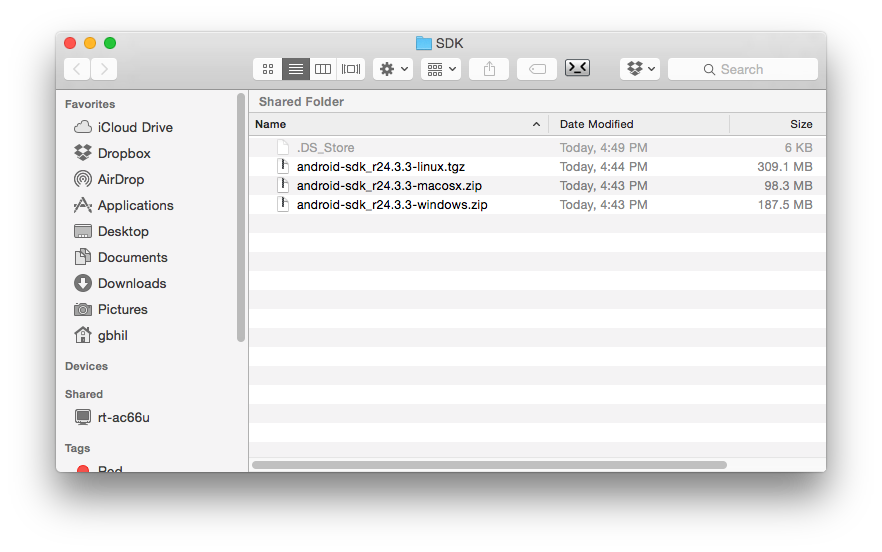The Windows 10 SDK (10.0.18362.0) for Windows 10, version 1903 provides the latest headers, libraries, metadata, and tools for building Windows 10 apps. Use this SDK to build Universal Windows Platform (UWP) and Win32 applications for Windows 10, version 1903 and previous Windows releases. Right-click the DEB package and select Install with Linux (Beta). Select whether you want to import previous Android Studio settings, then click OK. The Android Studio Setup Wizard guides you through the rest of the setup, which includes downloading Android SDK. Installing the Android SDK Android Studio provides everything you need to start developing apps for Android, including the Android Studio IDE and the Android SDK tools. If you didn't download Android Studio, go download Android Studio now, or switch to the stand-alone SDK Tools install instructions. Feb 24, 2019 Here's how to install Android SDK in Windows. Then you’ll first need to download and install Java. Pick the Windows “.exe” version from the list, then download and install it. Install SDK Command Line. Android Studio is a space-consuming app, and while we think its UI makes it a very accessible way of managing your development tools. Let’s install, setup and use android emulator in Windows, linux and Mac through command line without installing android studio. Best way to use emulator without losing space in you.
- Download And Install Android Sdk For Windows 10
- Android Sdk Tools Windows
- Ios Sdk Download For Windows
- How To Download & Install Android Sdk/adt Bundle For Windows
Topics:

Download And Install Android Sdk For Windows 10
You must have the Android SDK and developer tools to test and debug mobile applications for Android.
Go to the Android SDK download page at
http://developer.android.com/sdk/index.html.Scroll to the bottom of the page and expand GET THE SDK FOR AN EXISTING IDE.
Click Download the stand-alone Android SDK Tools for Windows.
Agree to the terms and conditions.
Click Download the SDK Tools for Windows, and then click Save File.
Save and then run
installer_rversion-windows.exeto start the Android SDK Tools Setup wizard.On the Welcome page, click Next.
After the wizard detects where the Java SE Development Kit is installed, click Next.
On the Choose Users page, select whether to install for anyone using the computer or just yourself, and then click Next
On the Choose Install Location page, enter the destination folder, such as
C:Androidandroid-sdk, and then click Next.Make a note of where you installed the files. You will need this information when you configure JDeveloper 11.1.2.4 in Task 3, 'Configure Oracle ADF Mobile for the Android Platform'.
On the Choose a Start Menu folder page, select the Start Menu folder or select Do not create shortcuts, and then click Install.
After the installation completes, click Next.
Ensure that Start SDK Manager is selected, and then click Finish.
You use the manager in the next task to install additional packages.
Because the emulator in later versions requires more memory and is slower, use Android 4.2.2 (API 17) to develop and test the Business Card Scanner mobile application. In addition to the Android 4.2.2 SDK platform and ARM EABI v7a system image, you must also install the Android Support Library, Google Cloud Messaging for Android Library, and Google USB Driver. Use the Android SDK Manager to select and install the packages.
Android Sdk Tools Windows

Ios Sdk Download For Windows

How To Download & Install Android Sdk/adt Bundle For Windows
If the Android SDK manager isn't open, complete one of the following steps:
From the Start menu, find and select SDK Manager.
Go to the folder that you installed the Android SDK in, such as
C:Androidandroid-sdk, and then double-clickSDK Manager.exe.You might need to run this executable file as an administrator. To do so, right click
SDK Manager.exeand select Run as Administrator.
The Android SDK Manager might take several seconds to start.
In the Packages section shown in the following figure, expand Tools.
Description of the illustration android-mgr-pkgs-tools.pngIn the Tools section, select the most current revision of the following, if they aren't already installed:
Android SDK Tools
Android SDK Platform-tools
Android SDK Build-tools
Select Android SDK Build-tools for revision 17 (in addition to the Android SDK Build-tools for the most current version).
Expand Android 4.2.2 (API 17), and then select the following packages:
SDK Platform
ARM EABI v7a System Image
Select Obsolete to include obsolete packages in the list as shown in the following figure:
Description of the illustration android-mgr-pkgs-ex.pngExpand Extras, and then select the following packages:
Android Support Library
Google Cloud Messaging for Android Library (Obsolete)
Google USB Driver
Click Install Packages.
Accept the license, and then click Install.
Close the manager.